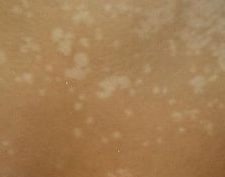When you notice discolored blotches appearing as pink, tan or white spots on your skin — specifically white spots from tanning — it could be from a skin condition known as tinea versicolor. Avoid suntanning because this could make it worse. Instead use sunless tanning products if you want a summer glow — but avoid oily skin care products.
What Is Tinea Versicolor?
Tinea versicolor is a fungal infection of the skin, also sometimes known as pityriasis versicolor. It is a fairly common skin fungal infection that can be chronic or long-term for some people, often returning during times when the weather is hot and humid.

This fungus has an impact on normal pigmentation of the skin, which is why it commonly causes white patches after tanning or spending time in the sun. The skin pigmentation can also appear as brownish red patches on the skin though.
Symptoms other than patches of skin discoloration can include mild itching. These patches can grow, appear scaly and they are more obvious after exposure to the sun. The areas of the body it most commonly affects include the back, neck, chest and upper arms.
Tinea Versicolor Causes
It is caused by a fungus that is normally found on healthy skin; tinea versicolor occurs when this fungus grows more than it is supposed to leading to an overgrowth of it. Factors that can increase the growth rate of this skin fungus include heat, humidity, oily skin and sweating excessively. It can also be caused if the immune system is compromised for some reason and not able to protect the body from excessive growth of this otherwise normal fungus.
To diagnose this your doctor, or dermatologist, simply needs to examine the affected area and take a skin scraping to examine it under a microscope.
Tinea Versicolor Treatment
Treating tinea versicolor usually includes the use of over-the-counter antifungal treatments including soaps or creams. Here are some common Treatments For Tinea Versicolor.
If over-the-counter antifungal treatments aren’t working your doctor can prescribe a topical or oral antifungal treatment. Common prescription topical treatments include Ketoconazole or Ciclopirox and oral treatments include Fluconazole or Ketoconazole tablets.
Unfortunately the skin discoloration can last for weeks or even months after successful treatment. And the fungal infection can return again during hot, humid conditions. Taking an occasional medication prescribed by your doctor may help prevent it from coming back during certain times of the year, but you may want to take other precautions as well.
Avoid sunbathing because this can trigger an overgrowth if you’ve already had a problem with this skin condition and make white spots on the skin or discolored patches more visible. Instead use sunless tanning sprays or airbrush tanning systems, but avoid oily products. Minimizing time in the sun will also help reduce the likelihood of developing melanoma symptoms. Shower after exercising and always put on clean clothes after showering. Wear breathable fabrics but nothing too tight. And practice sensible skin care routines.
Tinea versicolor can be an unsightly skin condition but it is treatable and luckily it isn’t a serious condition. Consult your doctor for an accurate diagnosis.
